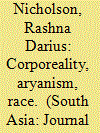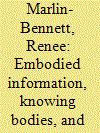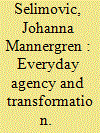|
|
|
Sort Order |
|
|
|
Items / Page
|
|
|
|
|
|
|
| Srl | Item |
| 1 |
ID:
142833


|
|
|
|
|
| Summary/Abstract |
Recent scholarship has problematised the ‘impact-response’ theory that ideas such as Aryanism, eugenics and militarism were merely imported from a European context into a South Asian one. This paper delineates a longer trajectory of the relationship between corporeal language and communal identity through a focus on the Parsi community of western India. As early as 1853, reformist Parsis enacted modes of ancient Kayānī virility in the gymnasium and theatre to redefine notions of communal identity that drew simultaneously from Enlightenment precepts and a mythic Aryan heritage discovered by Orientalists. Subsequently, the confluence of a loss of numerical, financial and political strength, and the popularisation of the ideas of Darwin and Mendel, prompted a shift in ethnic and semantic thinking, whereby the language of corporeality was co-opted by the orthodox faction to justify the bifurcation of religion and race. Consequently, Parsis, in the midst of a rising Hindu nationalist movement, called not only for the revival of Persian epic theatre, a Parsi militia, the exclusion of ‘half-castes’ from the community and the castration of ‘mentally defective’ community members, but also for a renewal of ties to Iran and a separate state of Parsistan.
|
|
|
|
|
|
|
|
|
|
|
|
|
|
|
|
| 2 |
ID:
123589


|
|
|
|
|
| Publication |
2013.
|
| Summary/Abstract |
The turn to materialism emerging in world politics scholarship promises fruitful ways of understanding power and political life by focusing on agency in the physical world. Yet immaterial information and 'the virtual' seem to dominate our lives. How can we understand the relationship between the material and the informational? Does this understanding promise any further insight into agency, power, and world politics? The focus in this paper is on the materiality (corporeality) and information of the human body as a special case. Embodied information is the information contained in the body that can potentially be accessed by others through an act of power. The way in which embodied knowledge is implicated in practices of world politics is exemplified by surveillance, DNA databases, and organ trade. Bodies are also the means by which information becomes sensible: we understand information from various sources and with various kinds of content through our bodies' ability to sense. This knowing body is also implicated in power, as exemplified by the use of sound and the augmentation of the senses through technology. Drawing on the interpretation of embodied information and knowing bodies, this article provides a pragmatic model of world politics in which to control how information flows, how it is extracted from the body, how it is inserted or received, how quickly, and to what end, is to have power or to be powerful.
|
|
|
|
|
|
|
|
|
|
|
|
|
|
|
|
| 3 |
ID:
166887


|
|
|
|
|
| Summary/Abstract |
How do we identify and understand transformative agency in the quotidian that is not contained in formal, or even informal structures? This article investigates the ordinary agency of Palestinian inhabitants in the violent context of the divided city of Jerusalem. Through a close reading of three ethnographic moments I identify creative micropractices of negotiating the separation barrier that slices through the city. To conduct this analytical work I propose a conceptual grid of place, body and story through which the everyday can be grasped, accessed and understood. ‘Place’ encompasses the understanding that the everyday is always located and grounded in materiality; ‘body’ takes into account the embodied experience of subjects moving through this place; and ‘story’ refers to the narrative work conducted by human beings in order to make sense of our place in the world. I argue that people can engage in actions that function both as coping mechanisms (and may even support the upholding of status quo), and as moments of formulating and enacting agential projects with a more or less intentional transformative purpose. This insight is key to understanding the generative capacity of everyday agency and its importance for the macropolitics of peace and conflict.
|
|
|
|
|
|
|
|
|
|
|
|
|
|
|
|
|
|
|
|
|